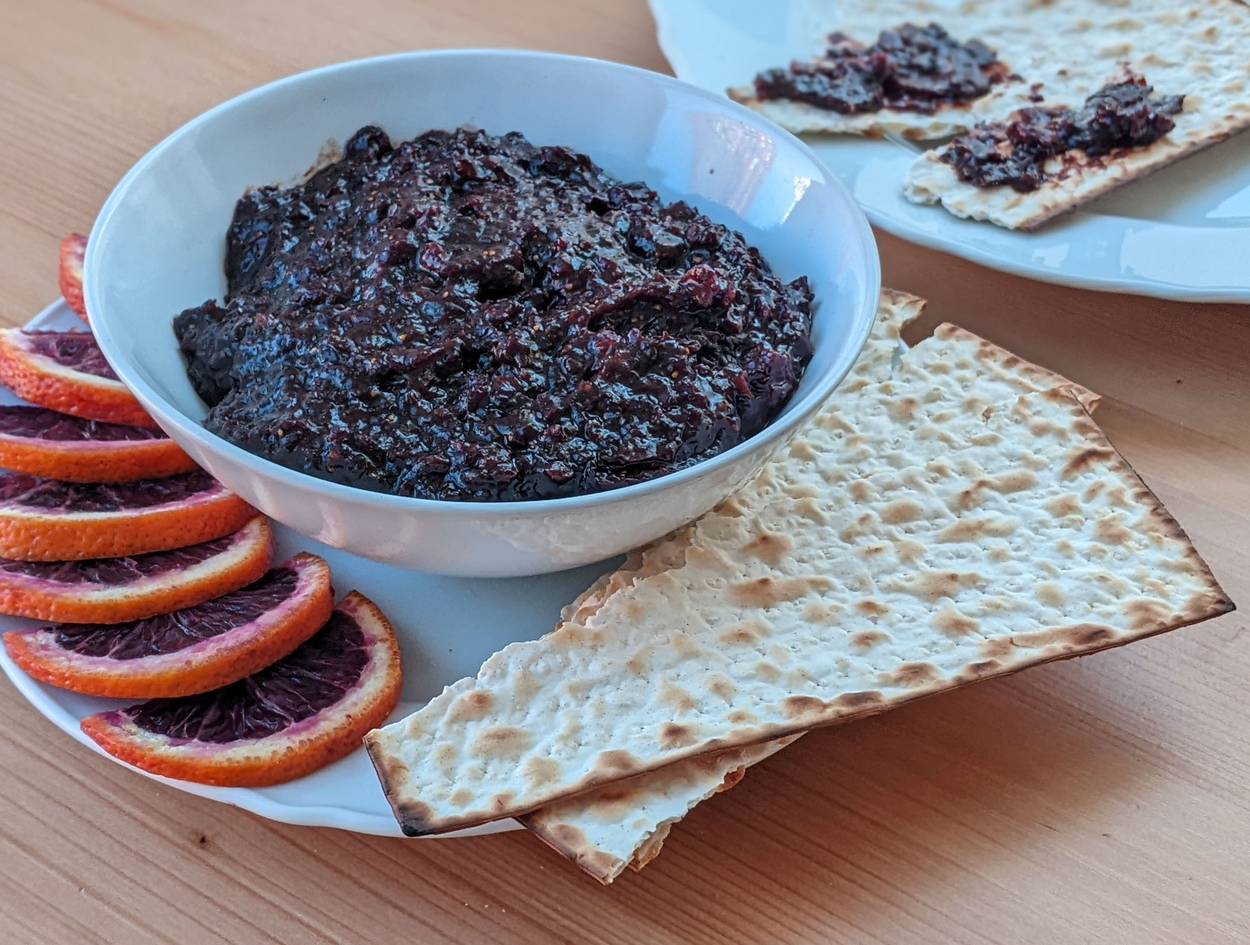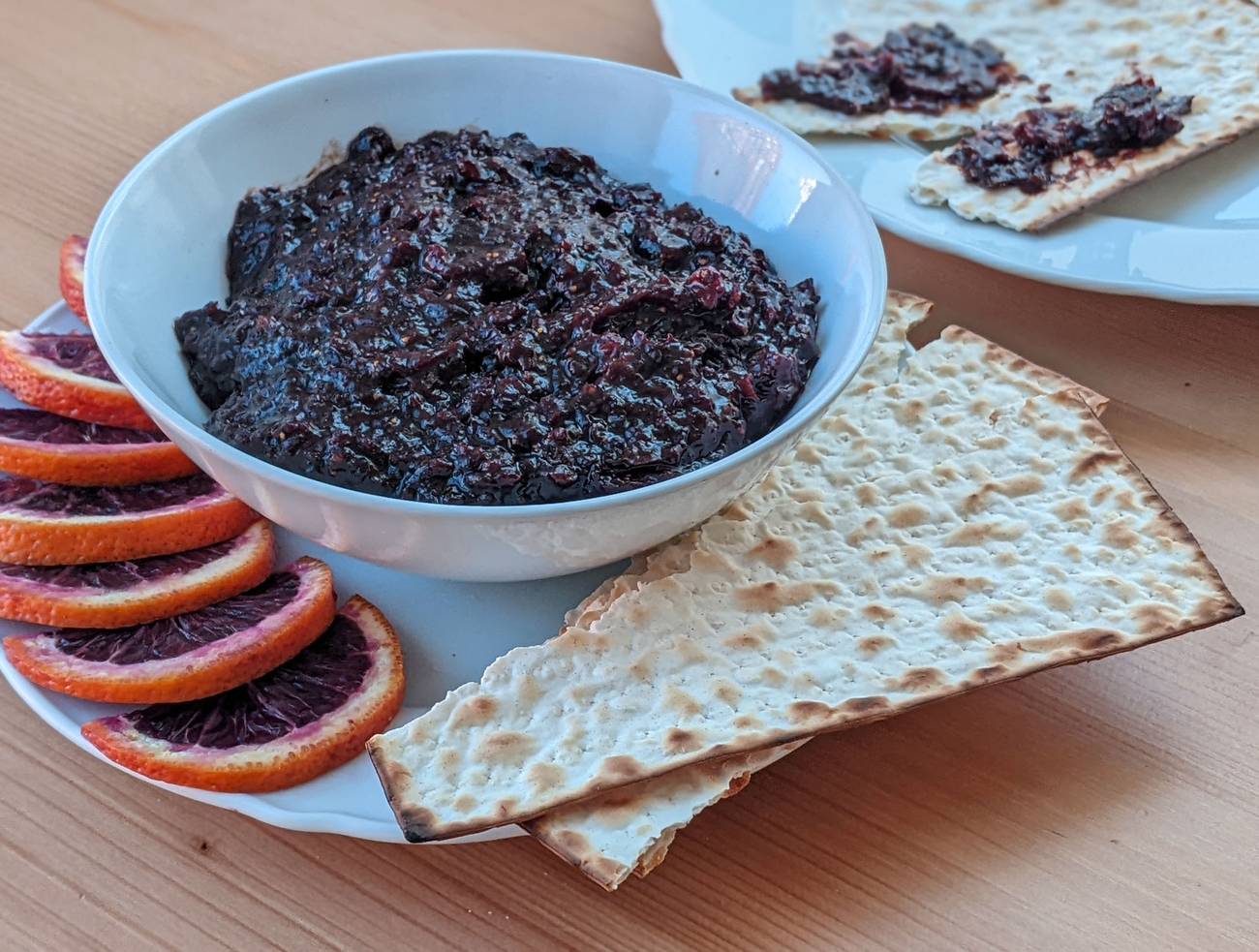The Darkness of Charoset
Recreating my great-grandmother’s long-lost Passover recipe helped me understand how she viewed herself before the family fled Egypt




Passover Seders were always a thing that my father merely seemed to tolerate, a spectacle he watched, somewhat reluctantly, from the far end of the table. His well-known dislike of all liturgy and especially of Seders had always made sense to me. For someone whose defining life experience was his own expulsion from Egypt, the notion of earmarking a strikingly similar ancient debacle must have seemed to him, admittedly, a little rich, especially given that one of his final memories of life in Alexandria was the last Seder his family had while living in his grandmother’s apartment. Time, sometimes, is too cyclical and too frustratingly ironic for its own good.
But in the spring of 2013, barely three months after his mother died, the lifelong holdout changed his mind. He wanted to commemorate that final Seder, to earmark his own historical debacle and his memories of a family that had now lost its matriarch.
With my mother’s brisket already well on the way, my dad wondered if I might help him prepare his grandmother’s charoset, since side dishes had fallen to me that year. The only problem was that he didn’t know the recipe. That would be easy enough, I thought, since, after all, wasn’t all charoset the same: a treacly mix of apples, walnuts, and golden raisins?
What I didn’t know was that my great-grandmother’s charoset was nothing at all like the apple blend I knew so well, but instead was a dark black paste. Nor did I know that I had accidentally stumbled into one of the richest and most debated subjects in all of Jewish cooking.
That first attempt in 2013 missed the mark spectacularly. What I produced for Passover that year was not a facsimile of an old family dish that took my father back to his childhood, but instead, a poorly formed mass of pulverized fruit in an unappetizing shade of brown that did not even make it to the table. That first failure led to what has become one of my longest holiday traditions of trying, and failing, to master my great-grandmother’s charoset—a tradition that finally ended (successfully) this year.
Almost as strange to me as the thought of methodically trying to reproduce the recipe of a woman I had not met was the idea that charoset could be something other than what I’d known my entire life.
According to Gil Marks’ canonical Encyclopedia of Jewish Food, charoset—the Passover Seder staple that is traditionally eaten over the kitchen sink in sticky matzo sandwiches during the week of Passover—rests at the center of a centurieslong Talmudic debate. While the most popular interpretation suggests that charoset symbolizes the muddy brick and mortar toiled over by Jewish slaves in Egypt, another interpretation based on the Song of Songs contends that charoset actually represents the apple orchards into which pregnant Jewish women absconded in order to avoid having their male offspring known to the Egyptian slave masters. A third interpretation, unsurprisingly, holds that the true meaning is actually a combination of the two other interpretations.
The ingredients themselves are no less contested than the symbolic origins. Ashkenazi charoset is usually made with apples as its base, whereas Sephardic charoset usually is a mix of dates and figs. But other versions can include raw orange or lemon peels, pomegranate seeds, raw quince, cherries, pistachios, walnuts, almonds, vinegar, ginger, bananas, and just anything else your great-great-great-great-great grandmother might have had on hand.
Every Jewish family seems to have its own variation of charoset, and each ingredient is like a strand in a tapestry that tells its own story of exile. There is perhaps no dish better suited to symbolize the ways in which Jewish diaspora continued to manifest itself long after the Exodus than this. To make charoset is to participate, willingly or unwillingly, in a form of choose-your-own-adventure Talmudic interpretation.
Marks concisely sums up the essence of charoset: “The Talmudic discussion emphasizes that the more symbolism we can impart to the charoset … the richer the experience will be.” Which is to say, the inception-charoset that weaves together layers of ancient Egypt, 1960s Egypt, my great-grandmother, my grandmother, my dad, and finally me, is so true to form.
Although the true origin of the food is unknown, it likely started out as an imitation of the ancient Greek fruit relishes, and was adapted and reinvented over time by Jews as they slowly began incorporating new ingredients of the terroir.
For my great-grandmother Esther, who was born in Turkey in 1880 (110 years before I was born), those ingredients would have been dried figs, dates, raisins, plums, and apricots.
Among relatives, my great-grandmother was known for her jam-making. My father particularly liked her marmalade, which included hand-curled orange rinds, and her jam of whole preserved green oranges. Her love of preserve-making also explains why my father remembers her charoset as being almost jammy.
Traditionally, Egyptian charoset is made with dates and figs, and is cooked in sweet wine, and macerated with spices and flavors like ginger and orange blossom water, and garnished with nuts. Traditional Egyptian charoset, however, is decidedly reddish brown, not black, and the difficulty of making a black charoset is compounded by the fact that every one of these fruits turns almost tawny when cooked in wine.
But on that Passover in 2013, I had made a critical miscalculation that was only pointed out to me this year by a cousin in France: It was extremely unlikely that my great-grandmother would have ever made a classic date-based Egyptian charoset. Dates were a more demotic ingredient that was more likely to have been found in the recipes of multigenerational Egyptian Jews. But given that my great-grandmother only arrived in Egypt in 1932, she barely had time to assimilate, let alone completely reimagine family recipes.
Knowing that my great-grandmother loved dried plums, I decided to try making the charoset again this year using raisins, dried plums, and a handful of only the blackest figs.
Ten long years of failure helped shape the rest of my recipe. For the sweet wine, I decided to use a darker ruby port rather than a lighter wine like vermouth or Marsala. I also knew that even though most recipes give instructions to cook the fruit at a low temperature for a long period of time, doing so leads to a lighter, browner charoset.
Instead, I combined the wine and fruit and aggressively reduced the mixture over high heat, and removed it from the heat almost as soon as the liquid had thickened to a deep purple. As the blade of the food processor spun, the plastic wall suddenly became splattered with a dark, jammy concoction roughly the shade of blueberry jam. Here at last was the dark paste my father had described to me.
I do not know much at all about my great-grandmother. I know she spoke mainly Ladino and French, that she was a formidable cook who liked to read from volumes of an encyclopedia, that she doted on my father the way my grandmother doted on me, and that in the final days before leaving Alexandria, after losing their home, my dad’s entire family moved in with her. Her home then, in those last days—in the days leading up to their last Seder—appeared to my dad like a place arrested in time. It felt to him as if it hadn’t been touched since the 1930s. But it was not a lifeless place, or even a pitiable place, but instead one that reverberated with a lush antiquity belonging to the previous century, which had been all but erased by the 1960s.
That is all gone now; it is no more real today than the lives of Jews in ancient Egypt. All I have are the highlights, the kind of trite banalities that descendants cling onto in the hope that they mean something, or that they offer some connection to these lost worlds. But if I ever got a sense of who my great-grandmother was, it was through a dish that told the story of my great-grandmother’s life, of her ancestry, of her likes and dislikes, the way she cooked and the way her dishes might have diverged from every codified recipe in any book or on any website, and that she saw herself not as Egyptian, but as a relic of the Ottoman Empire. Here, like her apartment on that last Passover, was a thing that had not changed since before even my dad was born. It is its own earmark; charoset, like a seance, for a split second seems to raise the dead. And this Passover, I cannot help but wonder, in half a century or more, which dish of mine will some stranger, who does not yet exist and who may never exist, finally manage to reproduce?
Alexander Aciman is a writer living in New York. His work has appeared in, among other publications, The New York Times, Vox, The Wall Street Journal, and The New Republic.